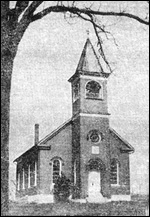The history of the white man in Dutch Corner begins at approximately 1730. According to the Bedford County Planning Comission….
“Settlers moving west breached the barrier of the Tuscaroras and spilled into Bedford County from the east beginning near 1730. The first farms in the central area of the County were developed in a rolling pocket in the mountains called Dutch Corner.”
Messiah Church is unique in being one of the oldest congregations in Bedford County. In E. H. Blackburn’s History of Bedford County it is stated that the congregation was organized about 1790.
Indian Eve
Of interest to many people is the fact that “Indian Eve” is buried in Messiah Cemetery (behind the church). She was Eve Earnest whose husband was massacred by Indians and she was taken captive. After 9 years of separation from her children, she returned to Bedford in 1786 and later married Mr. Conrad Sammel and lived where the Hinson Farm is now. She cooked the meals for the men building the log church and would hang a red handkerchief on a pole when the meals were ready. Her home was on the next hill in sight of the church. A monument was erected in her memory and appropriate ceremonies held on May 27, 1934.
1790 – The first church building
Messiah Lutheran Church was originally a log church of 30 by 50 feet, which was erected for worship service around 1790 and to this date, is the same plot of ground where the present building stands. At first this was called the Dunnings Creek or Dutch Corner Charge and was no doubt a union church, for the old records show lists of communicants marked “Reformed”.
The first recorded date in the Messiah Lutheran Church’s records is October 4, 1812. Only nine entries are recorded the next two years, so meetings were few and far between.
April 18, 1813 is the first recorded Communion date with 19 members communing and 16 new ones confirmed, J. P. F. Kramer, D. D., officiates.
J. P. F. Kramer, D. D. of the Bedford Academy serves this church until 1815 when a Rev. Mockenhaupt is listed. October 16, 1816, Rev. E. H. Tideman continues until 1819. Next was Rev. Osterloh, 1821-1825, followed by Rev. Yeager (who only speak in German) 1825-1841. All the church records up to 1840 are in German.
1844 – The second church building
Rev. Reuben Weiser served from 1841-1846. During this time the second church was built. This was a stone building 38 by 52. A date of dedication is not recorded, but it was no doubt in 1844. An articles of Agreement between the Lutheran and German Reform Congregations, for the building of a Lutheran Church in Bedford Twp was signed June 11, 1843. The church building was to be shared by the Lutheran Church and German Reformed Congregation, with the German Reform Church occupying the church building one fourth of the time as long as peace and harmony exist between the congregations.
 |
1869 – The third church building
The cornerstone was laid August 25, 1869. It was a frame building 36 by 60 feet, with end gallery, windows of stained glass, cupola and bell.
The Church was chartered under the title of Messiah Evangelical Lutheran Church of Dunnings Creek in 1875. Rev. John M. Rice served as pastor from 1883 to 1888 and during that time repairs were made to the church and a rededication service was held July 5, 1885.
 |
1906 – The fourth church building
In January 1906 the Church Council began to discuss plans for building a brick church.
In April the frame building was torn down and work begun on the new one.
A corner-stone laying service was held May 8, 1906 with a sermon by Rev. Hay of Baltimore, MD.
On the day of the cornerstone laying 108 names are listed as contributing a total of $60.00.
The new church was completed by fall and the dedication services were held on Sunday, October 28, 1906 with a large crowd.
On the day of the dedication many more names are listed and the offering was $1904.25
1962 – The new Christian Education Annex
In 1961 excavations was begun on a brick addition to the Church which would function as a meeting place for the Sunday School. This building was dedicated in September 1962 and has served this purpose well since then.
The major part of this Church History was written by Mary Holderbaum, 8-30-62
